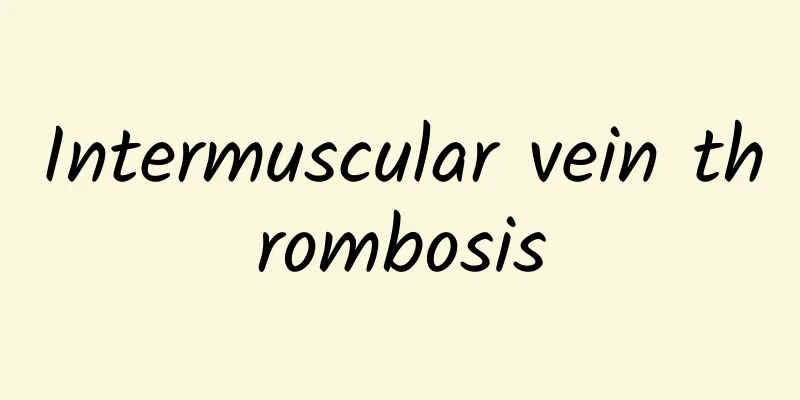Intermuscular vein thrombosis

|
In clinical work, I believe that many anesthesiologists have encountered patients with low echoes in the intermuscular veins during preoperative visits on color Doppler ultrasound of the lower limb arteries and veins, which is considered venous thrombosis, especially in patients with lower limb trauma and immobilization. Intermuscular vein thrombosis can be a minor disease or a major disease. The author recently encountered two patients with lower limb intermuscular vein thrombosis combined with pulmonary embolism. Fortunately, the patients' D-dimers were high. Pulmonary artery CTA was performed before surgery, showing pulmonary embolism. The relevant departments were consulted, symptomatic treatment was given in time, and anticoagulants were used. Although the operation went smoothly, it had to trigger our thinking. Let's learn about intermuscular vein thrombosis together. "Muscular calf vein thrombosis" (MCVT) is a primary thrombosis limited to the gastrocnemius and soleus venous plexus. It is a peripheral type of deep vein thrombosis (DVT) and a common vascular surgical disease. In recent years, with the widespread application of color Doppler ultrasound, the detection rate of MCVT has increased significantly. There are three high-risk factors for intermuscular vein thrombosis: immobilization, hypercoagulable state, and surgical trauma. Most of the clinical manifestations are asymptomatic, and some may manifest as soreness and pain in the calf, varicose veins, etc. There is a wrong view that isolated intermuscular vein thrombosis in the calf will not lead to pulmonary embolism. In fact, if no intervention is performed, some patients will spread to the proximal deep veins (femoral popliteal veins). In clinical practice, some patients with MCVT as the initial diagnosis subsequently developed symptoms of pulmonary embolism, and were diagnosed with pulmonary embolism by CTPA or pulmonary ventilation perfusion scanning. Therefore, MCVT is closely related to pulmonary embolism. There are also a large number of foreign literature reports that MCVT can cause the occurrence of pulmonary embolism and is one of the sources of thrombus in pulmonary embolism. Pulmonary embolism can be fatal, and some can be fatal in minutes, so if clinicians do not pay attention, do not treat it in a timely manner, the anesthesiologist does not conduct adequate preoperative visits, and the anesthesia risks are not fully assessed, serious adverse events may occur. The treatment methods for intermuscular vein thrombosis are divided into general treatment, drug treatment and interventional treatment. 1. General treatment for asymptomatic low-risk patients: immobilization and symptom relief are required, including bed rest and elevation of the affected limb. The purpose of immobilization is to prevent the detachment of blood clots and the occurrence of pulmonary embolism. The bed rest time should not be too long. It is recommended to get out of bed and move around early under anticoagulant treatment. When the condition permits, elastic stockings or elastic bandages can be worn to get up and move around. 2. Drug treatment: 1. Anticoagulant therapy: including acute heparin and low molecular weight heparin treatment, as well as long-term anticoagulant therapy with oral drugs such as warfarin. 2. Intravenous thrombolysis: For extensive acute proximal calf intermuscular vein thrombosis with a course of less than 72 hours, intravenous drip of urokinase, streptokinase or tissue-type plasminogen activator can be used to activate the conversion of plasminogen in plasma into plasmin, thereby dissolving the thrombus. 3. Interventional treatment: mainly includes direct catheter thrombolysis, inferior vena cava filter implantation, etc. For some special types of patients, including patients with recent active bleeding and other contraindications to anticoagulation, and patients with a history of pulmonary embolism and evidence of thrombus load progression, it is necessary to consult a vascular surgery specialist to consider whether to perform surgical intervention. When anesthesiologists encounter patients with preoperative intermuscular vein thrombosis, they need to weigh the pros and cons because the patients are waiting for surgery and anticoagulation and thrombolysis increase the risk of bleeding. They should pay attention to the patients' clinical manifestations, including swelling of the lower limbs and symptoms such as dyspnea, cough, hemoptysis, and chest pain. Laboratory tests: D-dimer, reference value: negative: < 0.5 mg/L; positive: > 0.5 mg/L, dynamic review at intervals of 2 days; color Doppler ultrasound of lower limb arteries and veins: review one day before surgery; lung imaging examinations: lung CTA, magnetic venous imaging, venography, etc.; blood gas analysis: often shows hypoxemia and hypocapnia, because pulmonary embolism is caused by blockage of the arteries by blood clots, which will affect normal gas exchange. If necessary, please consult with the cardiology and vascular surgery departments, listen to their opinions, actively treat patients with a high risk of thrombus detachment and combined with pulmonary embolism, and postpone surgery. For emergency and time-limited surgeries, fully explain the risk of thrombus detachment, prognosis and symptomatic treatment measures to the patients and their families, obtain informed consent, be fully prepared, ensure respiratory and circulatory stability during the operation, and provide symptomatic treatment to truly protect the patients. Yan Weina, Department of Anesthesiology, Zunhua People's Hospital [Warm Tips] Follow us, there are a lot of professional medical knowledge here, revealing the secrets of surgical anesthesia for you~ |
>>: "Overnight tea" is toxic and carcinogenic, so don't drink it? The truth is here
Recommend
Girls should not eat too much dietary fiber
In recent years, foreign scientists have observed...
When is a woman most likely to conceive? Grasp the best time to prepare for pregnancy
After getting married, many couples start prepari...
Four-dimensional health management: scientifically control the life code of weight, blood pressure, blood sugar and blood lipids
Reading time: 7 minutes (full text about 2000 wor...
Why is the vagina red, swollen and smelly?
Gynecological diseases are a new challenge that m...
[Medical Q&A] Why does a hard lump grow at the site of a fracture?
Planner: Chinese Medical Association Reviewer: Ha...
Is it good or bad to wear a bra when sleeping at night?
A statistical survey of 100 girls found that they...
What is the nutritional value of peanuts? How to eat peanuts in the most nutritious way
Although peanuts are small, they play a big role ...
Common knowledge about medication for children with Langerhans cell histiocytosis
What is Langerhans cell histiocytosis ? Langerhan...
Bleeding one year after menopause, beware of these diseases
We know that menstruation is a normal physiologic...
How much does Down syndrome screening cost?
Children with Down syndrome are born with a varie...
Gynecological medication
Gynecological medications are mainly divided into...
What is the reason for some pain and itching down there during menstruation?
Women's menstruation is really very important...
What are the dangers of using tampons?
Tampons are mainly made of cotton and synthetic f...
Lymphatic inflammation in pregnant women affects the fetus
The most obvious symptom of lymphadenitis is the ...
Small menstrual flow after cesarean section
The first issue after cesarean section is also of...









